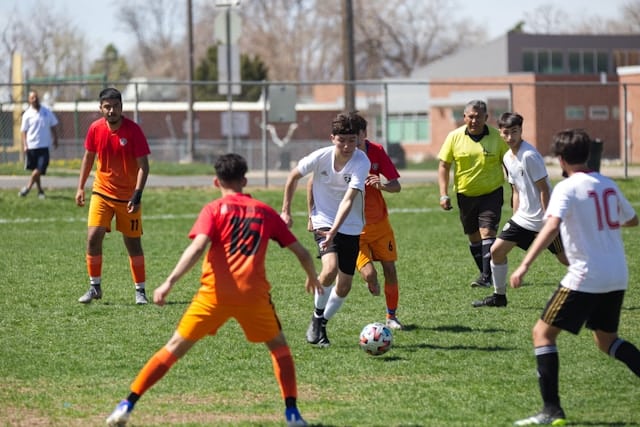As a team sport coach or athlete, you’re well aware of the role that a well-conceived and executed tactical plan can play in the outcome of a match. The right tactics, based on diligent study and backed by sound science, can often be the difference between victory and defeat. But what happens when your team is scheduled to play in an arena of a different size than you’re accustomed to? How do you adjust your tactical planning to accommodate these changes and ensure your team’s performance doesn’t suffer? In this article, we’ll delve into this issue, drawing on a wealth of data and analysis to provide you with the information and strategies you need to optimize your tactical planning in variably sized arenas.
Understanding the Impact of Arena Size on Team Sports Tactics
Before diving into the specifics of tactical planning, it’s vital to grasp the fundamental ways in which the size of an arena can affect your team’s game. The influence of arena size on tactics in team sports is a research area that is continually evolving, with new insights emerging all the time. We’ll distill down the most crucial points from recent studies and present them to you in a way that’s easy to understand and implement in your team’s training and game strategy.
Lire également : How Can Enhanced Visual Tracking Systems Improve Goalkeeping Skills in Hockey?
In team sports, the size of the field or court can significantly influence the tactical decisions made before and during a game. A larger pitch can potentially provide more space for offensive maneuvers, while a smaller one may require a more defensive strategy. The area available for play can influence a team’s positioning, player movement, and even the speed and intensity of the game.
Deciding how to adapt your tactics to the size of the arena requires a careful analysis of the specific rules and norms of the sport you’re involved in, as well as a deep understanding of your team’s strengths and weaknesses. Moreover, it also requires a firm grasp of the science-based principles of tactical planning in team sports.
En parallèle : What Are the Technological Advances in Swimwear That Reduce Drag and Improve Speed?
The Role of Sports Science in Tactical Planning
Sports science plays a crucial role in tactical planning for team sports. It provides the empirical data and rigorous analysis that can help to pinpoint the strategies most likely to contribute to a team’s performance, regardless of the size of the arena.
For instance, sports science can provide performance metrics that help you understand how your players perform in different environmental conditions, including various arena sizes. With this data, you can identify which players are most effective in a larger or smaller arena, allowing you to make informed decisions about team selection, positioning, and tactics.
Moreover, sports science can offer insights into how to structure your team’s training to prepare them for games in different-sized arenas. This may involve adjusting the intensity or focus of training sessions, or even altering the physical conditioning regime to ensure your players are physically equipped to handle the demands of different arena sizes.
Implementing a Tactical Planning System
Once you understand the impact of arena size on team sports and how sports science can inform your tactical planning, the next step is to implement a tactical planning system. This is where you take the theory and translate it into practice, devising a plan that your team can execute on game day.
The first stage of implementation is setting up a system for gathering and analyzing data. This might involve using performance tracking tools, video analysis, or specialist sport science software. Whatever approach you choose, ensure it allows you to capture a comprehensive picture of your team’s performance and the factors that influence it.
Next, you’ll need to devise a plan for how to adjust your team’s tactics based on the size of the arena. This will likely involve detailed match simulations and training sessions designed to replicate the conditions of different-sized arenas.
Remember, the key to successful implementation is practice and repetition. The more time your team spends training in conditions that replicate the match environment, the better prepared they will be to adapt their performance on game day.
Quality Tests and Performance Analysis
A crucial part of optimizing tactical planning for variably sized arenas is quality testing and performance analysis. This step involves examining the effectiveness of your tactics and making necessary adjustments based on the results.
Quality tests can take many forms, including simulated games, small-sided games, and individual drills. The purpose of these tests is to assess how well your team is adapting to the tactical changes you have implemented.
Performance analysis, on the other hand, is about examining the data from your team’s actual matches. This involves analyzing key performance indicators (KPIs), such as possession stats, passing accuracy, defensive solidity, and more.
In both these processes, the goal is to identify areas where your team is excelling and where improvements can be made. Incorporate these insights into your tactical planning, and your team’s performance in variably sized arenas will surely improve over time.
Leveraging The Power of Teamwork in Tactical Planning
The final piece of the puzzle in optimizing tactical planning for variably sized arenas is teamwork. Optimizing performance in different arena sizes is not just a matter of individual tactics and skills but of how well your team works together.
Coordinating your team’s movements, ensuring effective communication between players, and fostering a shared understanding of the game plan are all key to achieving the best possible performance.
Consider using team-building exercises or communication drills as part of your training regime. These can help to build a sense of unity and mutual understanding among players, which can translate into a more cohesive and effective performance on the field or court.
In conclusion, optimizing tactical planning for variably sized arenas is a complex but vital aspect of team sports coaching and management. By understanding the impact of arena size on team sports, leveraging the power of sports science, implementing a robust tactical planning system, conducting thorough quality tests and performance analysis, and emphasizing the power of teamwork, you can equip your team with the tools they need to excel, no matter the size of the arena.
The Power of Data Collection in Tactical Planning
Incorporating data collection into your tactical planning can provide a significant edge over competitors. The data collected can offer insights into aspects such as player performance, team dynamics, and arena-specific strategies. By using these insights to inform your tactical planning, you can increase your chances of securing victory, regardless of arena size.
There are several ways to collect this data. One of the most common methods is through video analysis. By analysing recordings of your team’s games, you can identify patterns and trends that may not be obvious during the heat of the match. This can help you understand how your players perform in different arena sizes and adapt your tactics accordingly.
In addition to video analysis, there are also several other tools available for data collection. Tools such as performance tracking devices, specialist sports science software, and even player surveys can provide a wealth of information about your team’s performance. The key is to select the tools that best suit your team’s needs and the specific requirements of the sport you’re coaching.
When analyzing the data collected, it’s important to use a system-based approach. This means considering all the different factors that can impact a game – including the size of the arena – and how they interact with one another. By taking a holistic view, you can gain a more comprehensive understanding of your team’s performance and make more informed tactical decisions.
Emphasizing Decision Making and Pattern Matching in Training
One crucial aspect of tactical planning that often gets overlooked is the role of decision making. This is particularly important when dealing with variably sized arenas, as the size of the arena can significantly influence the decisions players need to make during a game.
Training your team to make effective decisions under pressure can be the difference between victory and defeat. This can be achieved through a focus on pattern matching during training. Pattern matching is the ability to recognize patterns in the game and make decisions based on these patterns.
Training exercises can be designed to help players recognize common patterns in the sport and learn how to respond to them effectively. For example, you might set up a training drill that mimics a common game situation and requires players to make a specific decision based on the pattern they recognize.
In addition to pattern matching, it’s also crucial to emphasize decision making in a broader sense. This could involve training drills that require players to make quick decisions under pressure, or team discussions that encourage players to think critically about their decision-making processes.
Conclusion
At the end of the day, optimizing tactical planning for variably sized arenas is not a task to be taken lightly. It requires a deep understanding of the sport, the team, and the individual players. It involves careful data collection and analysis, and a focus on decision-making skills and pattern recognition.
However, the effort is well worth it. By taking the time to understand the impact of arena size on game tactics, and by using sports science and data analysis to inform your tactical planning, you can give your team the best possible chance of success – regardless of the size of the arena they’re playing in.
So, remember: Never underestimate the power of good tactical planning. It can be the difference between victory and defeat. And in the world of team sports, that’s a difference that can’t be overstated.











